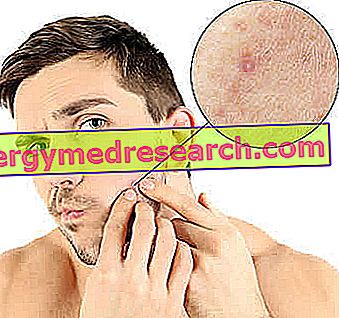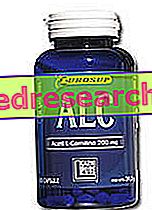What are
Pimples under the skin represent an imperfection that is as widespread as it is hated, which can affect any individual.

Features
Features and Aspect of Pimples Under-skin
The pimples under the skin appear as subcutaneous protuberances of varying sizes. In some cases, they may be small enough to be perceived only by touch, while in other cases they may be large and obvious. In other cases, on the other hand, they are not detectable by touch, but their presence is discovered because the skin tends to redden and be painful following pressure from the affected area.
Often, under the skin pimples are red and inflamed and, due to the pus trapped inside them, they appear as hard to the touch, sometimes even very painful.
Unlike the "classic" pimples to which we are accustomed, the pimples under the skin do not possess the typical white head and the inflammation that accompanies them remains trapped, precisely, at the subcutaneous level.
In some cases, however, the pimples under the skin can evolve, giving rise to pimples with the white head mentioned above (better known as white spots or closed comedones), or they can give rise to papules or cysts.
Please note
Sometimes, the subcutaneous pimples are identified with the so-called millet grains, small superficial cysts infused with keratin and with a semi-solid consistency, of which, however, it will not be discussed in this article (for more information: White Points - Millet Grains .
Causes
What are the causes and risk factors for the appearance of pimples under the skin?
The pimples under the skin are formed following inflammatory processes on the hair follicle, within which pus, bacteria, cellular debris and other material can accumulate.
The causes that cause this inflammatory process are many and depend on various factors, which can contribute to each other in giving rise to the disorder. Among these, we recall:
- Hormonal alterations (typical of adolescence or certain periods of life, as occurs, for example, in women during the premenstrual / menstrual period or during pregnancy);
- Excessive sebum production by the sebaceous glands;
- Poor, insufficient or inadequate skin cleansing with consequent accumulation of impurities and cellular debris that can clog the follicle causing inflammation;
- Use of cosmetic products and cleansing products which are too degreasing, irritating, of poor quality and / or not suitable for your skin type;
- Allergic reactions, both to cosmetics and to foods, drugs or other substances;
- Hepatic disorders (patients who suffer from liver problems and dysfunctions, in fact, can show symptoms also in the skin).
Furthermore, we remind that stress, an unruly lifestyle and rich in dangerous vices (such as smoking, excessive consumption of alcohol, etc.), an unbalanced diet and an uncontrolled and excessive exposure to the sun can favor the appearance of pimples under the skin.
Finally, the appearance of such imperfections could also be linked to a genetic component .
Incidence and Affected Areas
Incidence and areas most affected by the appearance of Pimples
Pimples under the skin can occur in individuals of any race and age, both in males and females. Despite this, the problem of subcutaneous pimples seems to be more widespread among adolescents, probably due to the considerable hormonal alterations that occur in this particular phase of life.
Although they can occur in any part of the body, under-eyes pimples tend to appear in certain areas, such as the face (in particular the T-zone, since it is generally characterized by a higher sebum production), the back and the thighs. In some cases, these pimples can also occur in the inguinal region, on the arms, on the armpits and on the scalp.
Signs and Symptoms
As mentioned, the pimples under the skin can be larger or smaller and be perceptible to the touch. In any case, this disorder usually manifests itself with the appearance of inflammation and consequent redness, associated with other symptoms of variable intensity, such as:
- Pain with or without pressure in the affected area;
- Itch;
- Swelling of the area where the pimple is present (due, in fact, to the inflammatory state);
- Cracked skin in the presence of imperfections.
Finally, let us remember that the appearance of the pimples under the skin can sometimes be complicated by the onset of bacterial infections.
Treatment
In some cases, especially when they occur in an isolated and acute form, the pimples under the skin do not need any kind of treatment, since they tend to regress spontaneously, therefore, to self-repel.
In cases where this does not happen, however, it may be necessary to intervene through targeted and specific treatments. For this reason, when the pimples under the skin become a serious and "debilitating" disorder for the patient (for example because they are very painful or because they remain on the skin for long periods of time), it is necessary to contact your doctor, or even better make a visit to a dermatologist. In fact, once the triggering cause has been identified, the specialist will be able to direct the patient towards the most suitable therapeutic strategy.
In these cases, of course, the type of treatment to be undertaken will be closely related to the cause that gave rise to the disorder.
For example, in adult female patients - if the pimples under the skin constitute a medical problem and are caused by hormonal alterations - the doctor may decide to intervene by prescribing the administration of oral contraceptives (of course, only if the patient does not is pregnant).
In case of allergies, on the other hand, it will be necessary first of all to avoid the contact or the intake of the agent responsible for the hypersensitivity reaction; while in the case of liver dysfunctions, the treatment will be aimed at restoring normal liver function.
If the inflammation is particularly intense and does not respond to other treatments, the doctor may decide to prescribe topical corticosteroid drugs, or, in particularly serious cases, for systemic use. Furthermore, in case of complications from bacterial infections, the use of antibiotic drugs may be necessary.
In other cases, however, the use of chemical peels or products based on exfoliating agents could be useful (and sufficient).
However, before resorting to any type of treatment and / or use of any drug, it is necessary to seek medical attention.
Natural remedies
Nature can also help in the treatment of under-the-skin pimples. In fact, some plants are very useful for this purpose, in particular, the essential oils extracted from them. This is the case of melaleuca essential oil (better known as Tea Tree Oil), rosemary essential oil and lavender essential oil .
The essential oil of lavender and melaleuca, in fact, have interesting anti-inflammatory and antimicrobial properties, which could be useful in reducing the inflammatory state that accompanies the pimples under the skin. Rosemary essential oil, on the other hand, has antimicrobial, dermopurifying and astringent properties and can be useful especially in the case of oily skin.
Generally, it is advisable to apply a few drops of essential oil on a cotton pad, with which you can then dab the area affected by the pimples under the skin.
However, when using these natural products, pay attention to possible allergic reactions and to the possible onset of skin irritations, especially in sensitive skin. Not all skin types, in fact, could respond well to the application of pure essential oils. Possibly, it could be useful to dilute the essential oil selected in a little aloe vera gel, another natural product with anti-inflammatory and healing properties.
Prevention
Can pimples under the skin be prevented?
As the pimples under the skin are a disorder that can occur in any individual, without distinction of sex, race and age, in some cases these annoying imperfections can be prevented by adopting a few simple behavioral measures and maybe even making some small changes to your style of life.
In particular, in order to prevent the disorder, it could be useful:
- Follow a healthy and balanced diet (a practice that is useful for maintaining the well-being of the whole body and not just the skin);
- Avoid excessive consumption of alcohol and vices such as smoking ;
- Use quality detergents and cosmetics, suitable for your skin type;
- Daily cleanse the skin, but do not overdo it with the frequency of the washes (too intense washings, in fact, push the skin to produce greater quantities of sebum and this could worsen the situation in the case of under-spots);
- Perform a scrub on the skin of the face and body at least once a week (in this way, in fact, the dead surface cells are removed and cell renewal is promoted);
- Avoid squeezing or crushing the pimples under the skin . A similar practice, in fact, in addition to being completely ineffective (since the material enclosed in them fails to come out by simple pressure), can cause skin lesions and favor the expansion of any bacterial infections in progress.
Finally, it is good to remember that the skin - even if it has pimples under the skin - must always be hydrated through the use of cosmetic products adapted to your skin type. Dehydration, in fact, contrary to what one might think, can cause a further worsening in the manifestation of the pimples under the skin.



